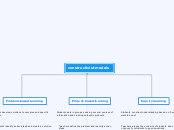constructivist models
Problem-based learning
Students develop solutions to complex and specific problems.
Students identify action steps and create a solution.
Keys:
A problem acts as the focus of learning
The problem provides integration of many concepts and skills required in the resolution of the problem
A problem solving process is required
A commitment to self-learning is required
Importance:
Through the process of problem-based learning, students become aware of a need for knowledge as they work to resolve the problems.
Project-based learning
Students work in groups seeking several sources of information and creating authentic products.
Teachers define the problem and identify action steps.
Keys:
Establishing Real-World Connections in Projects
Building rigorous projects That Are Core to Learning
Structuring Collaboration for Student Success
Facilitating Learning in a Student-Driven Environment Embedding Assessment Throughout the Project
Importance:
It's an in-depth investigation of a real-world topic worthy of children’s attention and effort, which helps students develop skills for living in a knowledge-based, highly technological society.
Inquiry learning
Students construct understanding based on "need or want to know"
Teachers arouse the curiosity of students and offer chances for students to pose questions.
Keys:
All learning activities should focus on using information-processing skills
Inquiry learning puts the learner at the center of an active learning process
The role of the teacher becomes one of facilitating the learning process
Importance:
Through the process of inquiry, individuals construct much of their understanding of the natural and human-designed worlds.
